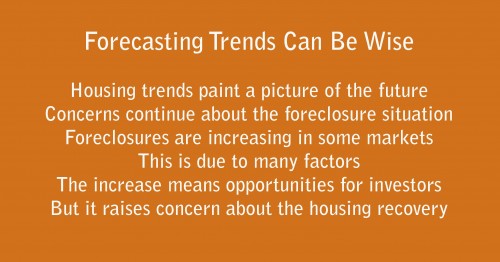 The biblical King Solomon didn’t put much faith in predictions. But according to the words of his Proverbs, the prudent monarch did believe in wise planning for the future – looking ahead based on the knowledge of present conditions. In real estate, too, experts consider past trends and present conditions to forecast likely scenarios about the health of the rebounding housing market. One such benchmark is the number of foreclosures in a given quarter – a number which, after a period of decline, is rising in some major markets around the country. This trend raises concerns about the housing recovery in general as well as opportunities for investors.
The biblical King Solomon didn’t put much faith in predictions. But according to the words of his Proverbs, the prudent monarch did believe in wise planning for the future – looking ahead based on the knowledge of present conditions. In real estate, too, experts consider past trends and present conditions to forecast likely scenarios about the health of the rebounding housing market. One such benchmark is the number of foreclosures in a given quarter – a number which, after a period of decline, is rising in some major markets around the country. This trend raises concerns about the housing recovery in general as well as opportunities for investors.
The dust is clearing from the original mortgage crisis of the past few years. Some lenders are imposing stricter standards on borrowers and attempting to work with struggling homeowners to avoid foreclosure; it appears that the conditions for large numbers of foreclosures simply don’t apply any more. But the lingering aftermath of those conditions are still contributing in some ways to the current foreclosure situation.
Recent foreclosure statistics indicate that while foreclosure activity has been decreasing annually in markets such as San Francisco, foreclosures are, in fact, increasing in cities such as New York, Tampa, and Chicago.
One reason new waves of foreclosures are hitting the market has to do with delayed processing of foreclosure actions from the original round of mortgage defaults. As we’ve discussed in previous posts on the foreclosure market, so many foreclosures were being processed at the height of the meltdown that these cases created a backlog for both lenders and the courts, with delays of more than 1,000 days in some situations. These foreclosures are still being processed, so the properties involved will be released for sale as the cases clear.
Some foreclosures were purchased in lots and held by major lenders and real estate groups, to be placed up for sale in bulk lots at an unspecified future date. These properties are available for sale only to invited investing groups, rather than to everyone, a practice raising objections by some real estate groups and individual investors. Nevertheless, these foreclosures will be placed back into circulation as rentals.
Other ways foreclosures enter the “pipeline” involve tax lien sales, in which an investor buys a lien placed on a property for back taxes and forecloses the house if the owner can’t pay the tax debt. And some homeowners attempting to qualify for a short sale or other mortgage relief may face foreclosure when those assistance measures offered by the lender don’t resolve their financial issues.
The number of foreclosures expected to go up for sale in 2012 is unclear. The numbers depend partly on whether Fannie Mae and private real estate organizations will continue their practice of selling bulk lots of the homes they hold to investment groups and whether homeowners opting for short sales to avoid foreclosure will actually succeed.
Whether the increase in foreclosure really means instability in the housing market or not, these homes remain an attractive investment for income property investors applying Jason Hartman’s strategies for smart, wealth-building investing.
The Solomon Success Team

